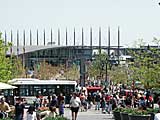5.4
Develop the Centre’s tourism potential
The Centre is the main tourist destination in Montréal, which enjoys a well-deserved reputation as a festive, convivial and safe city. The CBD, Old Montréal, the Old Port, Île Notre-Dame, Île Sainte-Hélène, Mount Royal and the Village are among the areas that draw the most tourists to Québec.
The concentration of large-scale cultural and recreational facilities, such as museums, concert halls and large metropolitan parks, combined with the quality of major annual events taking place in the Centre (Jazz Festival, Just For Laughs Festival, World Film Festival, Francofolies, Montréal Highlights Festival, etc.) greatly enhances Montréal’s fame as a tourist attraction.
The City’s French-speaking character, combined with the importance of its English-speaking and other cultural communities, make for a unique environment that appeals to visitors and attests to Montréal’s openness to the world.
 The exceptional built heritage and geographical setting of the Centre adds to its appeal as a tourist destination. The Havre, which encompasses Île Notre-Dame, Île Sainte-Hélène, the Old Port and the entrance to the Lachine Canal (now open to pleasure boating) is a major recreational and tourist destination.
The exceptional built heritage and geographical setting of the Centre adds to its appeal as a tourist destination. The Havre, which encompasses Île Notre-Dame, Île Sainte-Hélène, the Old Port and the entrance to the Lachine Canal (now open to pleasure boating) is a major recreational and tourist destination.
The Parc Jean-Drapeau is a majestic green space, a point of contact with the river and an exceptional asset which the City must preserve. Working from this perspective, the City intends to enhance its recreational and tourist attractions while preserving its character as a green open space and respecting the principle of universal accessibility.
These distinctive features of Montréal are the foundations for its tourism development. For this reason, the Plan provides for their consolidation and enhancement.
Generally speaking, the Centre is the preferred location for new tourist facilities with metropolitan, national or international outreach. Nodes of activity outside the Centre, such as the Olympic Complex, with its several large scientific facilities (Biodome, Insectarium, Botanical Garden), could be consolidated in order to accommodate additional facilities that reinforce their vocation.